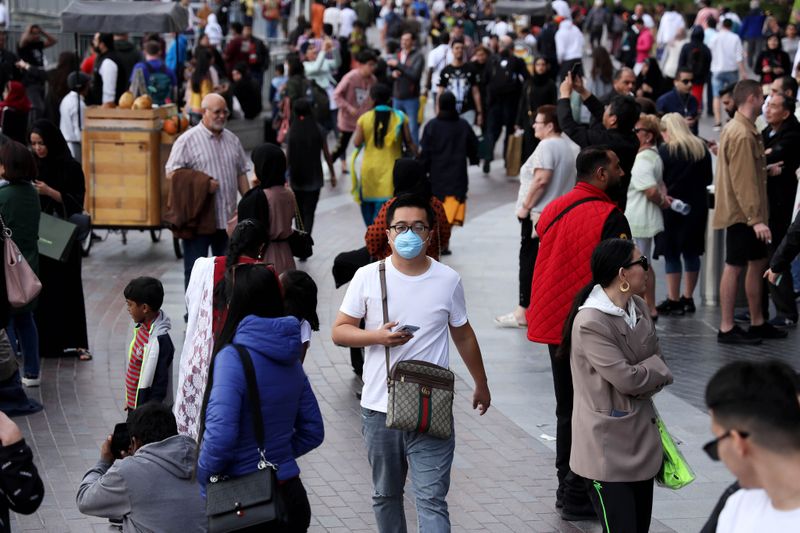
Dubai: A Beijing physician, who was to speak about novel coronavirus at the International Family Medicine conference in Dubai today, has cancelled his trip after his organisation imposed global travel restrictions.
Dr D.J. Hamblin-Brown, Vice President of Medical Affairs at the United Family Healthcare, Beijing, however, responding to Gulf News queries from the UK, said life has changed beyond recognition after the COVID-19 outbreak and that they were many lessons to be learnt by the world from the experience.
Excerpts from the exclusive interview:

Q: As a lead physician in emergency medicine in Beijing, what is your overview of COVID-19?
A: My view is formed through daily conversations and meetings with many of my colleagues across China who are having a very tough time everywhere. Daily life has changed out of all recognition. A vibrant country is in virtual lock-down everywhere. This is a huge public health experiment.
It’s never been tried before. So I think we can say with some certainty that the decisiveness and courage of the Chinese people will be recognised when this epidemic is over.
Their attempts to slow the disease have probably protected untold lives in other parts of China and the rest of the world.
Regarding the virus itself, my view is that the disease is not very dangerous to most individuals, but the rapid spread makes the epidemic potentially very dangerous, mainly because it threatens the integrity of health systems when infection rates rise above a certain level.
That seems to be what has happened in Wuhan.
Q: Could the rapid spread have been avoided? What more needs to be done?
A: Probably not. The unchecked transmission (called “R0”) is perhaps 2 or 3 which is something like ‘flu - or perhaps higher.
There have been numerous examples of individuals infecting tens of people - this is almost impossible to contain. Transmission seems to occur for some days (possibly weeks) before symptoms appear.
RO is the basic reproduction number of a virus which is defined as the expected number of secondary cases produced by a single (typical) infection in a completely susceptible population. For instance, the RO for influenza is 1.8. In infections with minimal trasmissions, the RO is 1.0.
Finding ways to slow the spread will help health systems cope - but this is best done by reducing social contact and good hand hygiene. The evidence (so far) would suggest that the virus is not easily contained.
Q: Is there reason for us in the Middle East to fear that this crisis is soon going to be a pandemic?
A: I think it is inevitable that this will spread to all parts of the world, but there are reasons to be hopeful. Viruses tend to become less dangerous as they spread (because being less dangerous helps them spread). We have also the possibility of a vaccine within the next year or two.
Some virologists have said that is overly optimistic — but it’s still possible.
It is also possible that the virus is seasonal — and will not spread so fast in hot countries or during the summer.
Q: Is quarantine the best option once an individual tests positive?
A: To be clear, quarantine is the isolation of unknown cases. This is not the same as isolation of known cases. Unless quarantine is performed on a huge scale, like China has done in Hubei, then it won’t really work to contain the virus, only slow down its spread.
Q: What more can be done in the UAE to guard against the virus ?
A: I don’t think we will be able to contain the spread, only slow it down. UAE and other countries - with a lot of international travellers — could consider three things: mandate the wearing of masks in public places, cancel large public gatherings and conduct high-profile public health campaigns on simple hygiene measures.
All of these would be money well spent. The question really is about timing of these measures. We don’t want to leave it too late.
Q: What role does food nutrition play in fighting the infection?
A: Anyone with reduced immunity will do worse with this disease than people who are fit. Good nourishment is important but the people most at risk are those with existing medical conditions and people over 65.
Q: Could you give us a list of the little known features of the virus?
A: The virus is very normal. It is spread through small droplets (cough/sneeze), contact (touching your face, surfaces that are not clean — possibly for up to 48 hours).
The idea that it ‘hangs around in the air’ is only really applicable to healthcare settings where we do things like dentistry and intubation.
There are simple things that can help reduce spread: Hand hygiene, not touching your face, keeping surfaces clean, dealing with coughs, sneezes appropriately, wearing a simple face-mask in company and ensuring your u-pipes in your bathroom don’t dry-out.
The most important thing is hand hygiene.
Q : What is the best way forward to combat COVID-19 going by our experience with SARS, EBOLA and MERS
A :Good public and private hygiene methods will slow the disease and allow us to treat all cases effectively. Uncontrolled spread could cause serious problems for health systems, especially in poorer parts of the world.
Viruses that kill people don’t get very far. Ebola had a 50 per cent death rate. It was relatively easily spotted and contained.
Viruses that are not very dangerous are more likely to spread undetected. As I said, the problem is having a huge surge in cases locally so that health systems can’t cope. This makes isolation and treatment very difficult and can cause a vicious circle.
Q: What lessons can the world draw from this experience?
Openness of information is our most powerful weapon against disease. Whether that’s on case load, epidemiology, genetics, treatment … this will help us work together. China has done some of these things very well.
Myths and facts on Covid-19 virus
Myth:Virus originated through bats and probably cross jumped to humans from snakes
Fact: Bats maybe. Snakes? Probably not. Anyway, this is irrelevant. All viruses have come to us through animals at some point.
Myth: A lot of people feel that apart from being spread through the droplets of body fluids and contaminated surfaces, the virus might be airborne?
Fact: Not in the sense that it will hang around for ages waiting for you in the park. Aerosol — which is the technical word — requires a really big sneeze, or to do dentistry, or intubate someone. This is all infection at close quarters. From what we know of other similar viruses, it is unlikely that the virus hangs around on dust or pollution particles.
Myth: Masks are the best way to protect oneself
Fact: Hand hygiene is top. Simple masks when in company are good — but mainly because you don’t want to spread the diseases to others.
Myth: The virus might have more than a 14-day gestation
Fact: Possibly — we don’t really know. The main problem is that some people can be carriers without showing symptoms.
Myth: Contracting the virus is a death sentence
Fact: Completely the opposite. Young fit people are very unlikely to die. Children are also — as far as we can see — the least likely to do badly.
Myth: Vaccine for the virus may not be ready for a year
Fact: It will take more than year for it to be developed, tested, manufactured and made available in a pharmacy near you. There are technical difficulties with coronavirus vaccines.








